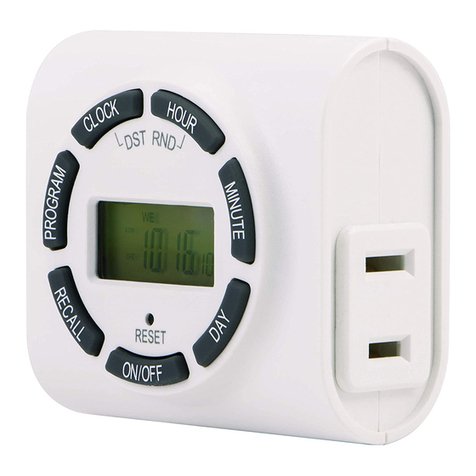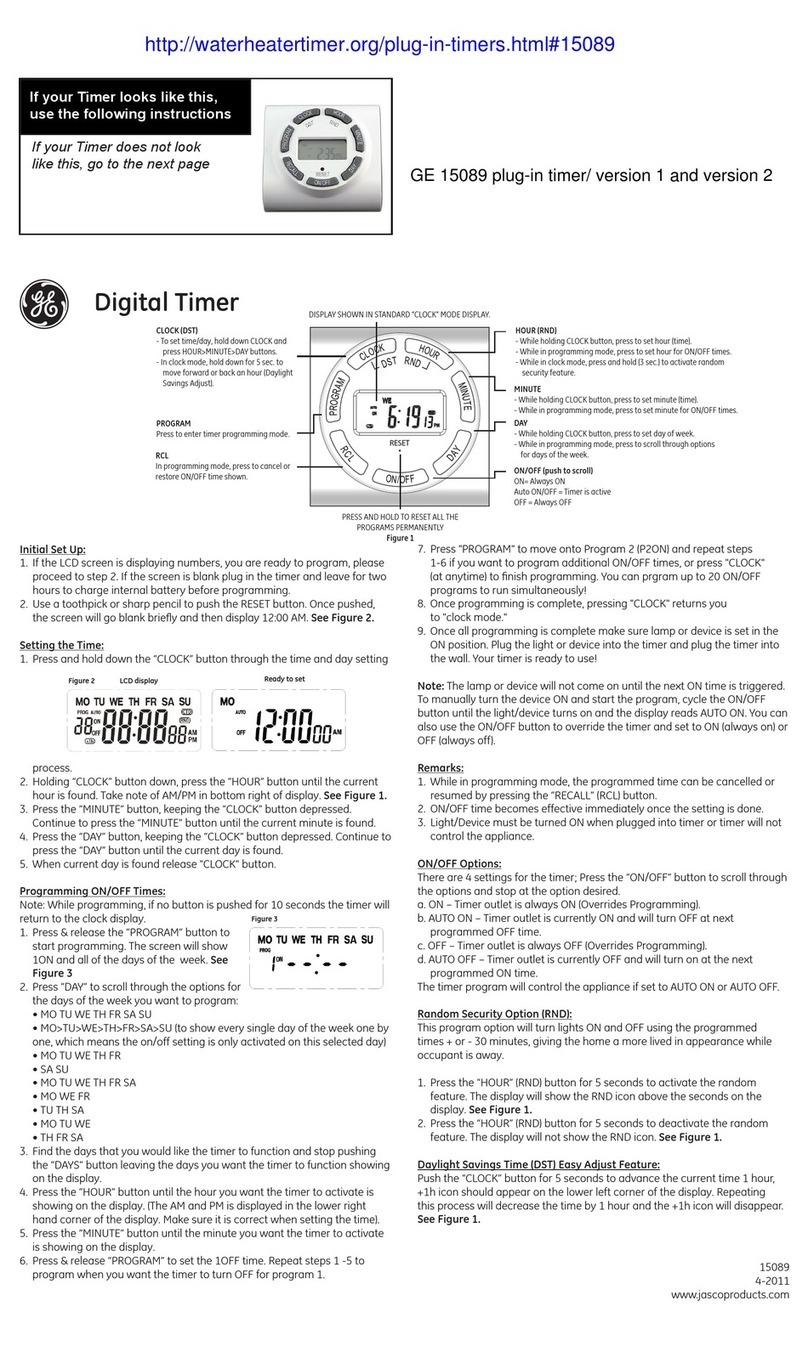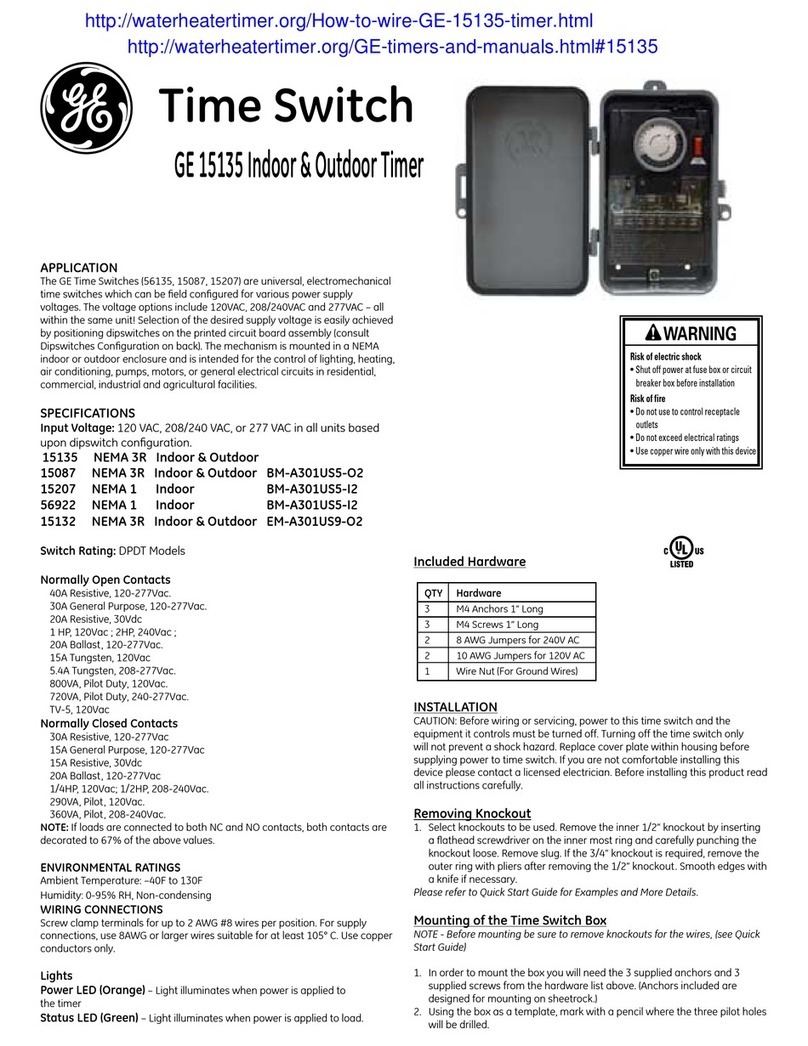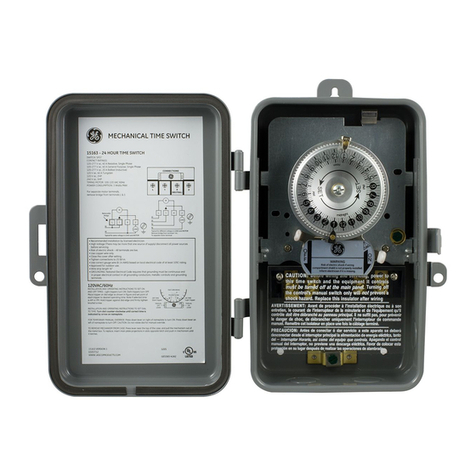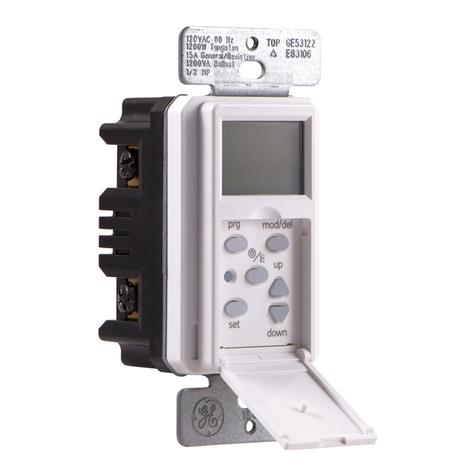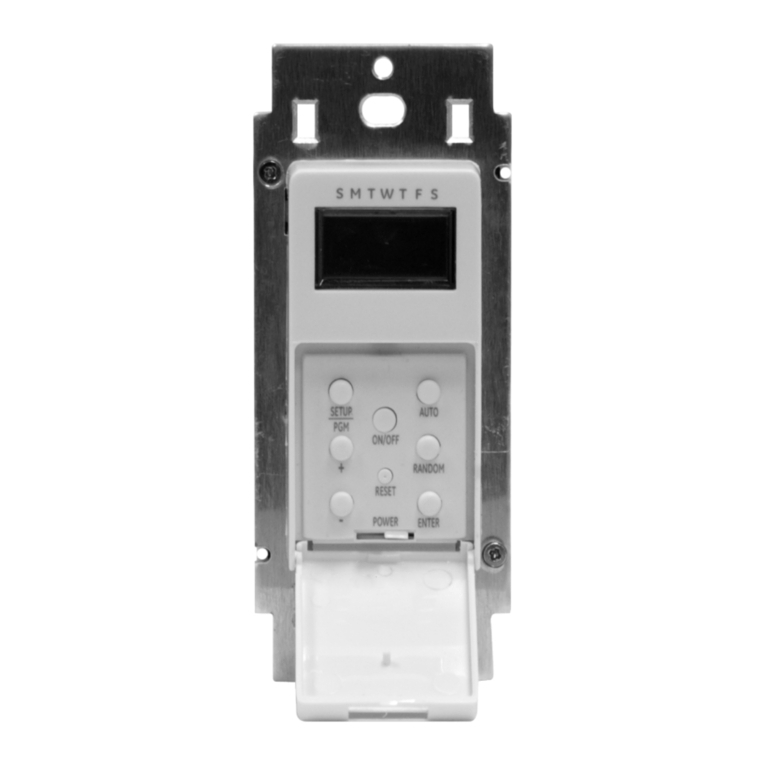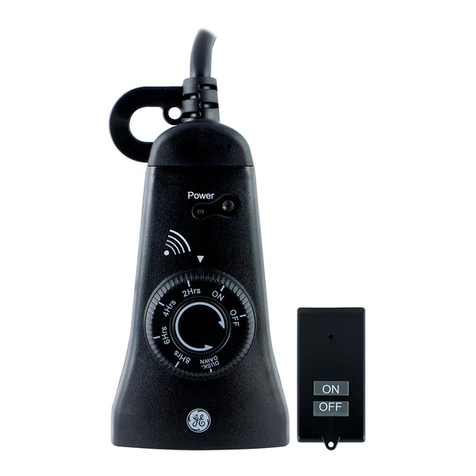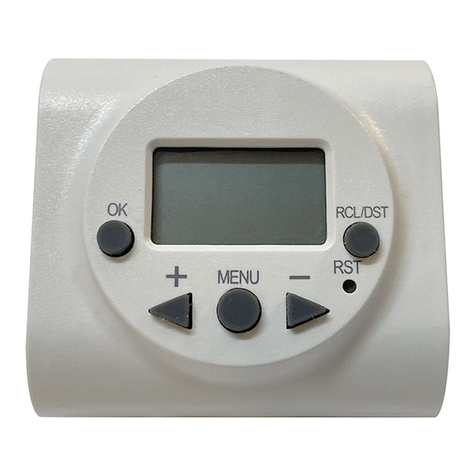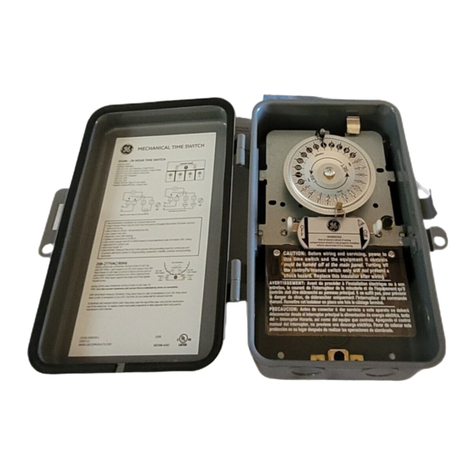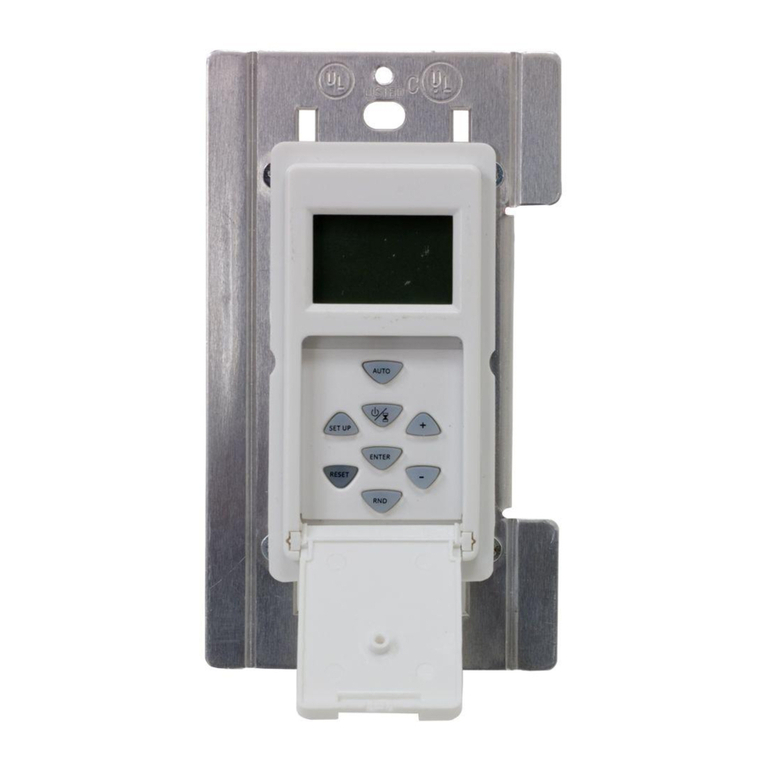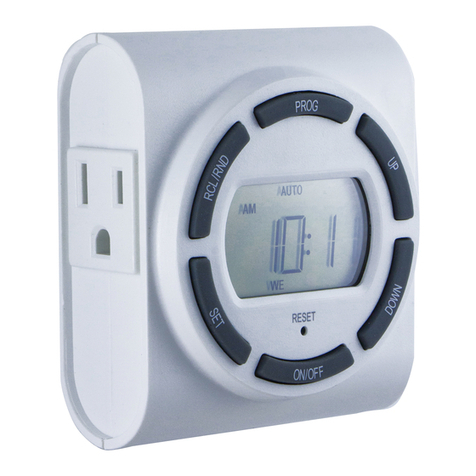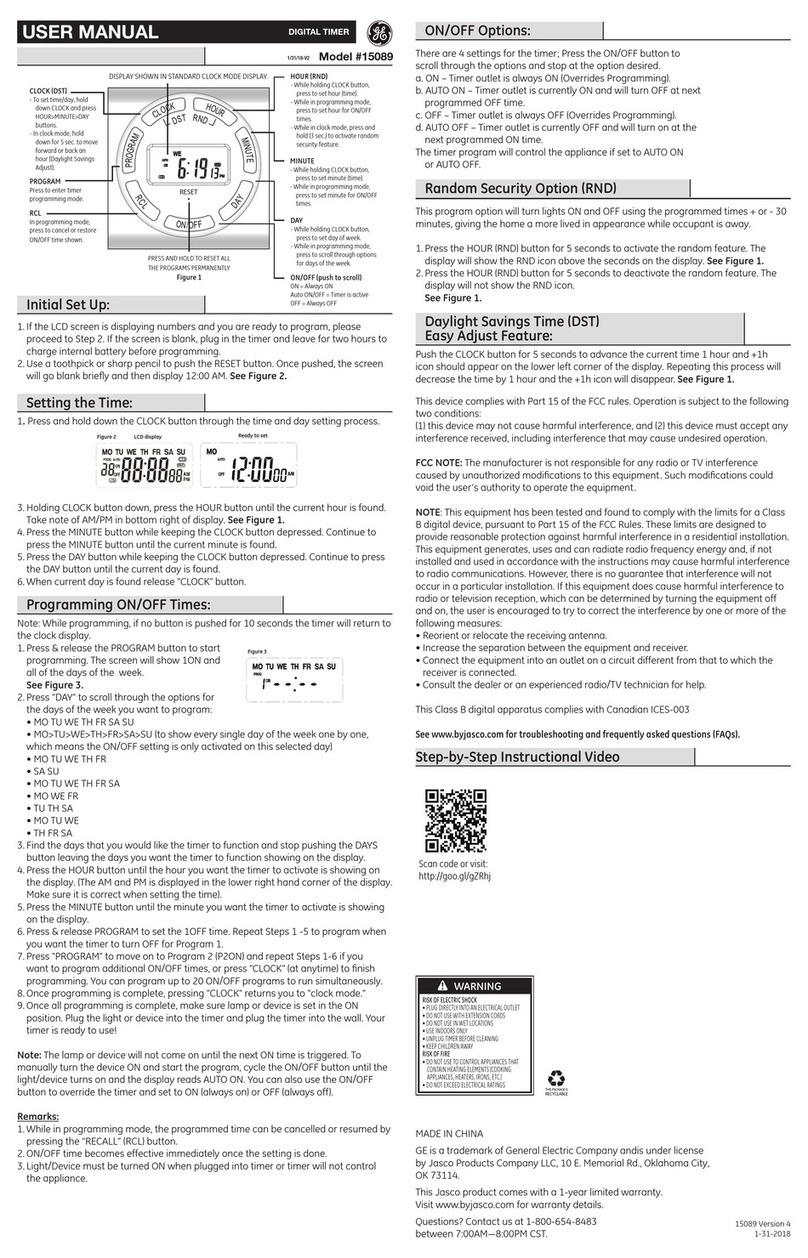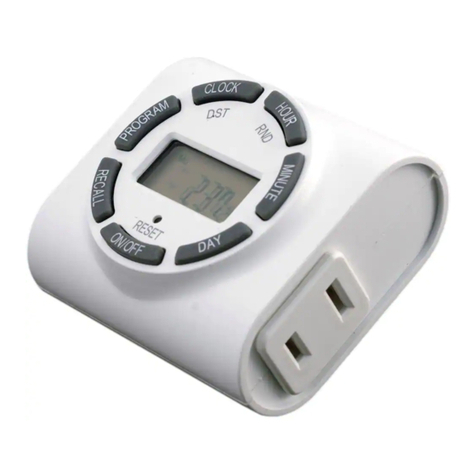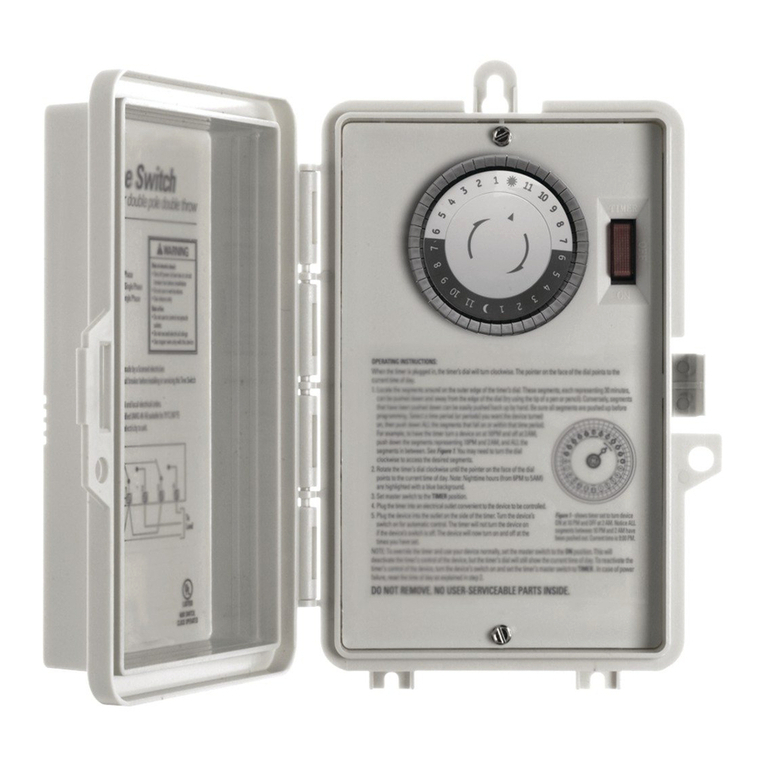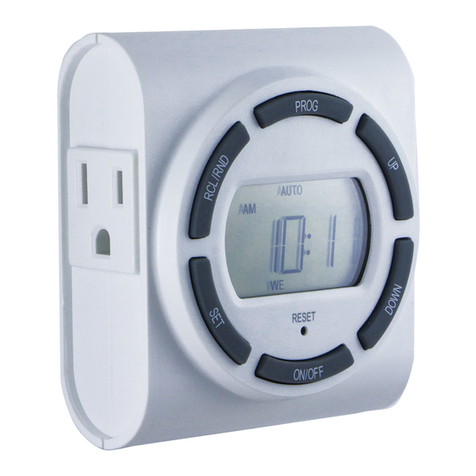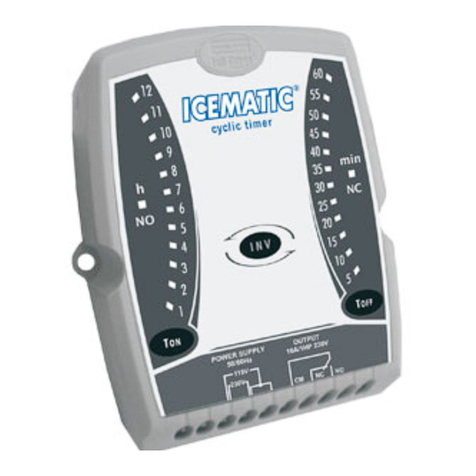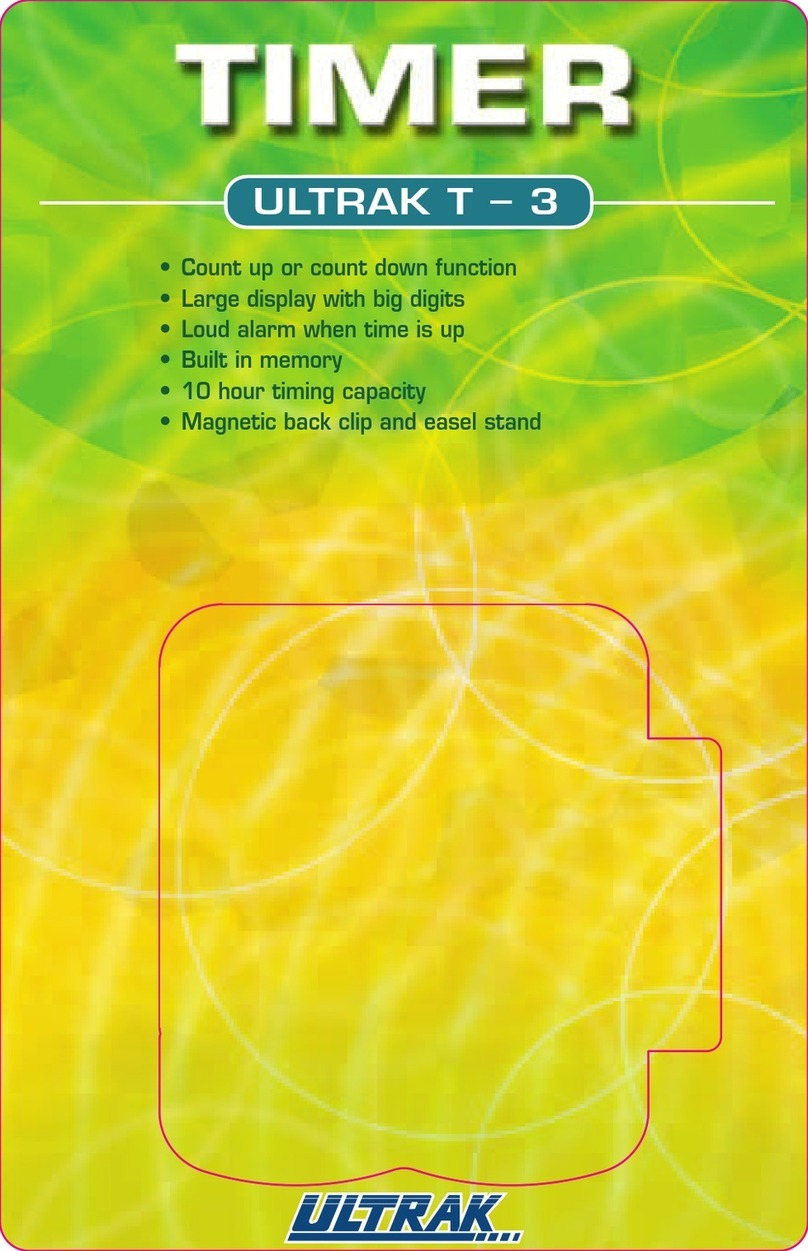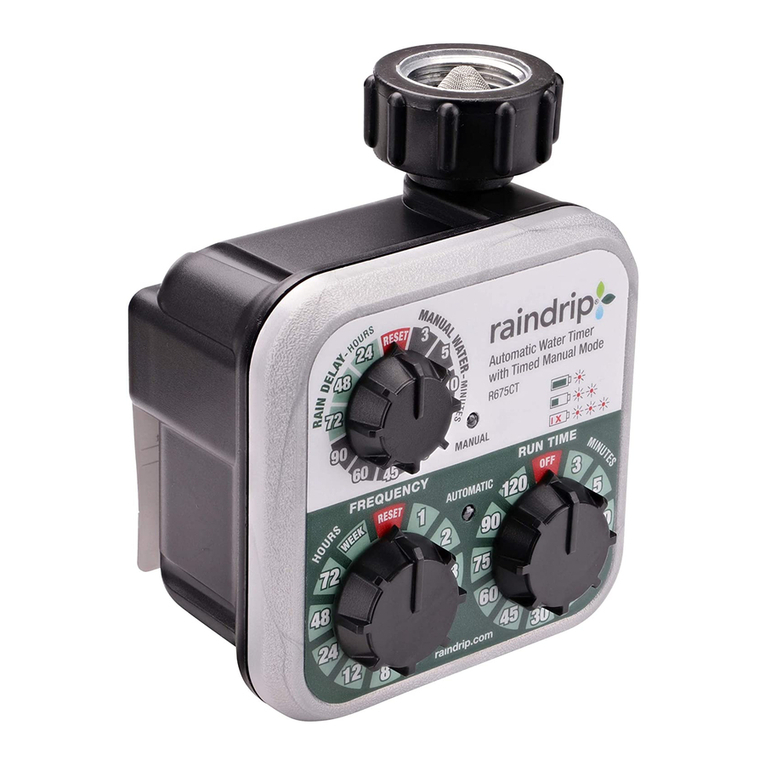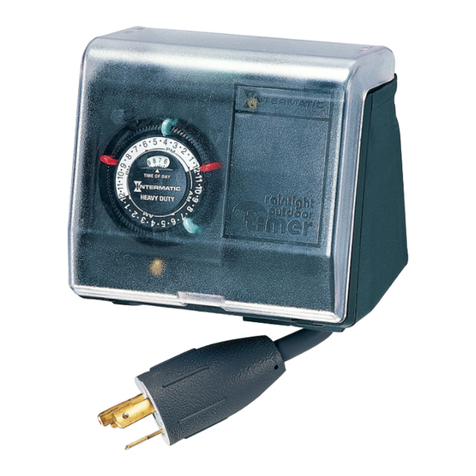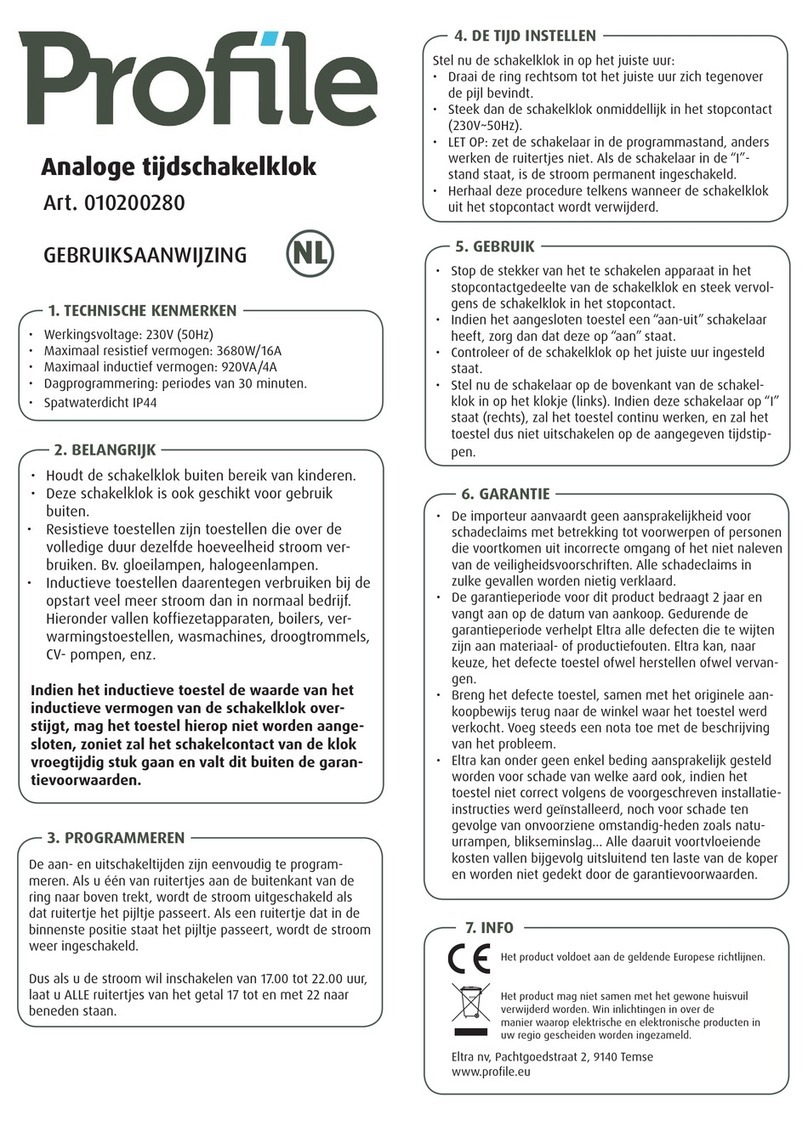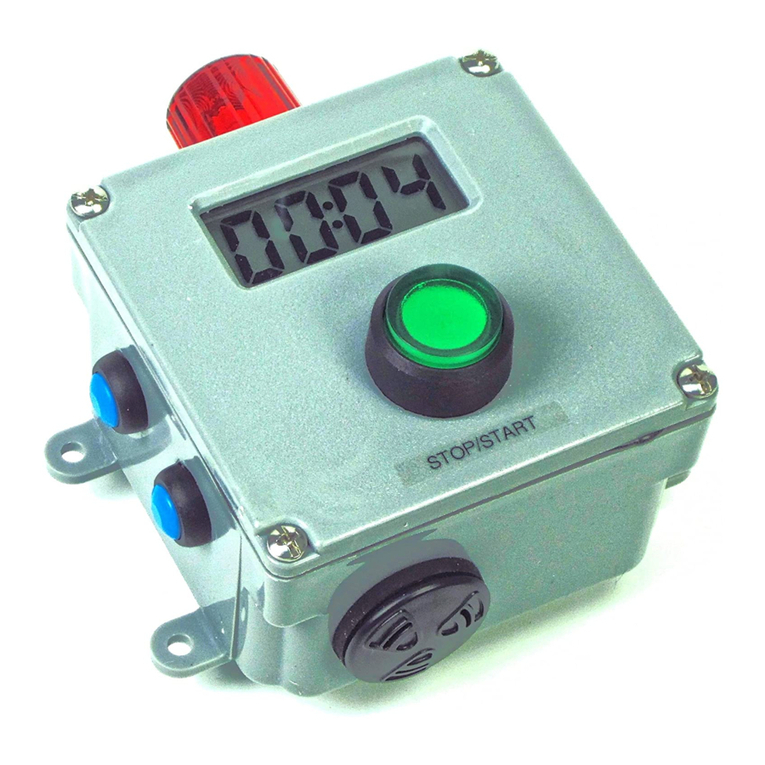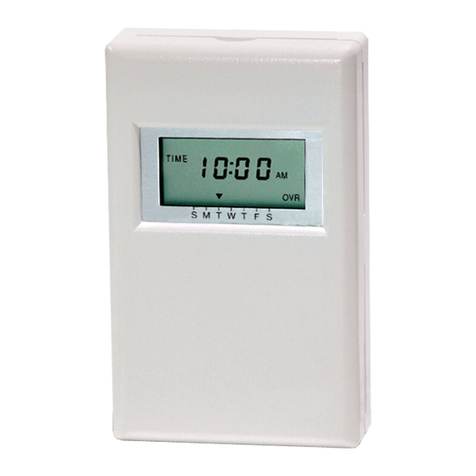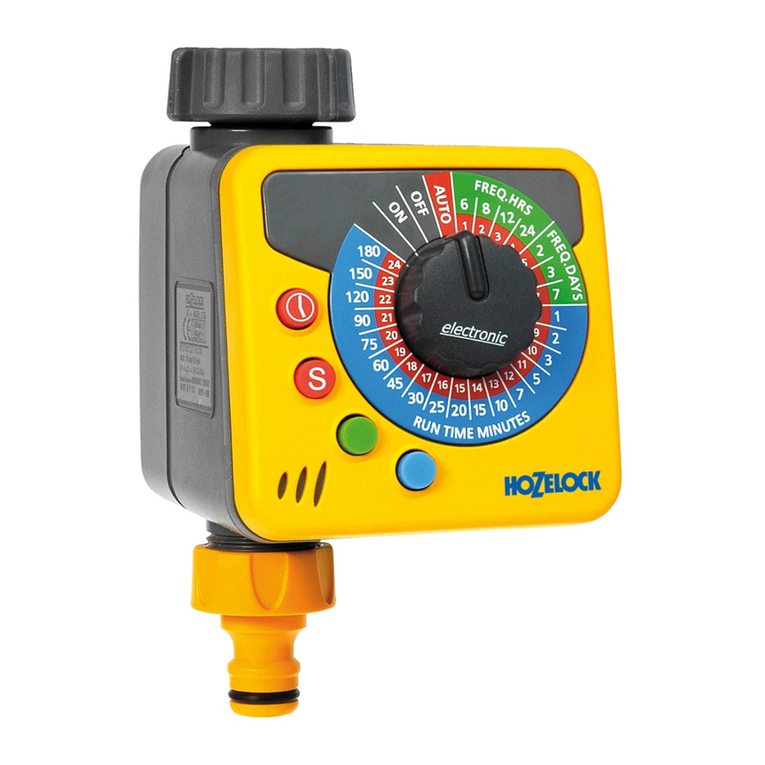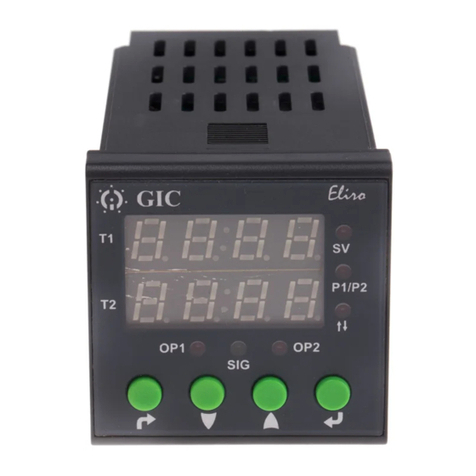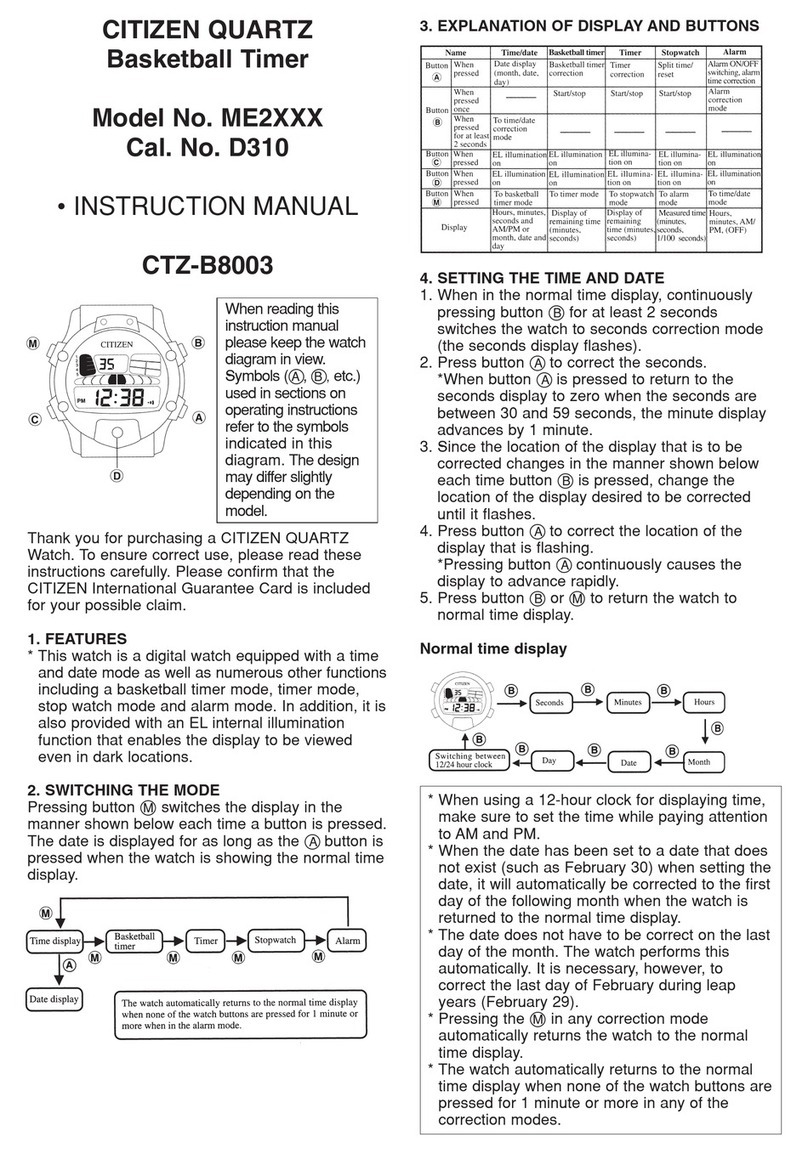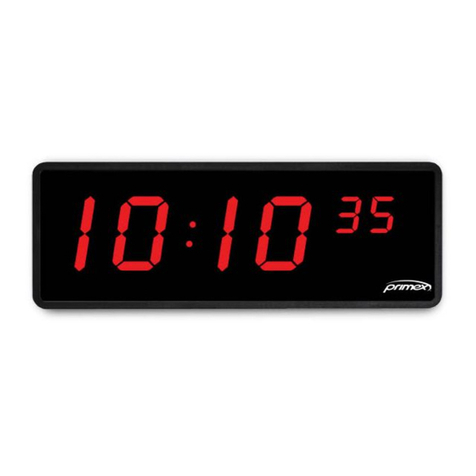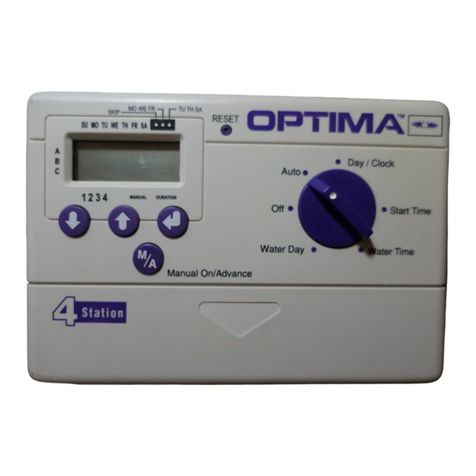In-wall
SunSmart™ Digital Timer
A - PROGRAM (prg): Press to set daily
ON/OFF times.
B - MODE/DELETE (mod/del): Press to
choose from auto, manual or random
modes. When the timer is in Program
mode (prg), this button deletes program
settings.
C - RESET: Push to reset the timer to default
settings.
D - ON/OFF and TIMER OVERRIDE: Press to
turn load ON/OFF and press and hold to
start the Countdown function.
E - SET: Press to set the calendar, clock, dusk,
dawn and daylight savings settings.
F - UP/DOWN BUTTONS: Press to scroll
through timer setting options.
G - TIMER DOOR: Close after programming.
Press to turn ON/OFF (TIMER OVERRIDE).
NOTE: The timer will automatically return to
the clock mode if a button is not pushed for
60 seconds. Push the setup button once to
return to program mode if this happens.
Setting up the timer for the first time:
1. Using a toothpick or a pencil, gently press RESET (C) to clear all programming and
set the timer to default settings.
2. Press the SET (E) button to begin setting the time and calender.
The time “12:00 AM” will be flashing. See Figure 7.
3. Use the UP/DOWN (F) buttons to set the current time, taking note
of the AM and PM on the display. Press SET (E) when the current
time is displayed.
4. Use the UP/DOWN (F) buttons to select the year then press SET (E).
5. Use the UP/DOWN (F) buttons to set the month then press SET (E).
6. Use the UP/DOWN (F) buttons to set the day then press SET (E).
7. When DST appears on the display (see Figure 8), use the UP/
DOWN (F) buttons to turn DST ON/OFF then press SET (E).
NOTE: Choose DST ON if your local area observes Daylight
Savings Time. The timer will automatically adjust backwards
and forwards an hour. Choose DST OFF if your local area does
not observe Daylight Savings Time.
8. If you selected DST ON, the display flashes “ZONE.” Proceed to
SETTING THE DAWN/DUSK REGION (ZONE) below.
NOTE: This step does not set your time zone. In this step you are identifying your location
based on this map to ensure an accurate dawn and dusk time for your area.
Setting the dawn/dusk region (zone):
View Figure 9 and determine which zone best fits your location using the up arrow. The
options are NOR: North, CENT: Central, SOUT: South, ALAS: Alaska, and HAWA: Hawaii
1. Use the UP/DOWN (F) buttons to select the zone where the
timer is installed then press SET (E). See Figure 10.
2. Use the UP/DOWN (F) buttons to set the dusk time then
press SET (E). The approximate dusk time will be flashing. The
approximate time may be changed + or – 2 hours in order to
find the desired dusk time. See Figure 11A.
3. Use the UP/DOWN (F) buttons to set the dawn time then
press SET (E). The approximate dawn time will be flashing. The
approximate time may be changed + or – 2 hours in order to
find the desired dawn time. See Figure 11B.
4. Press SET (E) to complete setup and the timer will return to
clock mode.
Setting the dawn/dusk region (zone):
A. Programming the ON/OFF days
1. Press the PROGRAM (prg) (A) button to begin programming times. The
display will show Program 1 on. See Figure 12. Press PROGRAM (prg) (A)
to scroll through the remaining ON/OFF programs until you reach an
available program (if you are programming multiple programs). There
are 7 ON/OFF programs available. Once you are on the correct program
press SET (E).
2. Use the UP arrow (F) button to scroll the days of the week the timer will activate:
□MO, TU, WE, TH, FR, SA, SU (Default)
□MO through SU: Individual days
□MO, TU, WE, TH, FR
□SA, SU
□SU, MO, TU, WE, TH
□FR, SA
3. Press SET (E) to select your desired days of the week setting. Proceed to Step 2 - Programming the
ON/OFF time.
B. Programming the ON/OFF time
1. Press UP/DOWN buttons (F) to choose from one of these three options to
begin configuring the timer’s ON time. Press SET (E) to choose your setting
option and PROGRAM (prg) (A) to proceed to Step 2.
□TIME: Press the UP/DOWN (F) buttons to set any customer time, taking
note of the AM/PM on the display. See Figure 13.
□DUSK: Sets the timer to the DUSK time that is displayed. See Figure 14.
□DAWN: Sets the timer to the DAWN time that is displayed. See Figure 15.
2. Press UP/DOWN buttons (F) to choose from one of the three options to begin
configuring the timer’s OFF time. Press SET (E) to choose your setting option
and PROGRAM (prg) (A) to proceed to Step 3.
3. Repeat Steps A and B to set additional programmed ON/OFF times (up to 7
total).
To exit programming mode and return to clock mode, press and hold the
PROGRAM (prg) (A) button for 3 seconds, or do not press any buttons for 20
seconds.
Additional programming options:
A. Reviewing programs
Press the PROGRAM (prg) (A) button to scroll through the existing ON/OFF programs (7 maximum).
B. Deleting programs
Press the PROGRAM (prg) (A) button to scroll through the existing ON/OFF programs. Stop on the program
to be delete and press MODE/DELETE (mod/del) (B) to delete. The screen will show the program has been
deleted.
C. Setting the random (RND) security option
The Random (rnd) feature will turn lights on and off using the programmed times + or - 30 minutes, giving
the house a more lived in appearance while the occupant is away.
To activate Random, press MODE/DELETE (mod/del) (B) until RND flashes on the
screen. To turn off, press MODE/DELETE (mod/del) (B) again to enter the manual or
automatic setting. See Figure 16.
Additional Features:
A. Using the three available timer modes (optional)
Press MODE/DELETE (mod/del) (B) to scroll through the available modes.
AUTO - (Automatic) Timer is set to Automatic and will follow the selected program (1-7).
MANU - (Manual) Timer does not follow a program. Turn the lights ON and OFF by pressing the
door (G).
RND - (Random) Timer will turn lights on and off using one of the existing program
times + or - 30 minutes.
B. Countdown mode
Press and hold the ON/OFF (D) button for about 3 seconds.
1. Use UP/DOWN (F) buttons to select countdown time (default is 1 hour). See Figure 17.
2. Stop on the time desired and the timer will countdown. The time
chosen will become the new default. If using default countdown
time of 1 hour, press the door (G) for 3 seconds and countdown
function will begin. Lights will turn off once countdown has
completed. Hold the ON/OFF (D) button for 3 seconds to cancel
the countdown.
Troubleshooting:
3-way switch will not work.
• Make sure jumper wiring is correct.
Lights on all day controlled by timer.
• Check to make sure the clock time is set for correct AM/PM.
• Check to make sure Dusk time and Dawn time are not reversed.
Lights come on and off at times different than they programmed.
• Check to see if there are multiple programs on the timer that conflict with each other.
• 3-way switch may have been used to turn lights off or on; the timer should function correctly during the next
program cycle.
FCC NOTE
This device complies with Part 15 of the FCC and Industry Canada license-exempt RSS standard(s).
Operation is subject to the following two conditions: (1) this device may not cause harmful interference,
and (2) this device must accept any interference received, including interference that may cause
undesired operation.
FCC NOTE: The manufacturer is not responsible for any radio or TV interference caused by unauthorized
modifications to this equipment. Such modifications could void the user’s authority to operate the
equipment.
NOTE: This equipment has been tested and found to comply with the limits for a Class B digital device,
pursuant to Part 15 of the FCC Rules. These limits are designed to provide reasonable protection against
harmful interference in a residential installation. This equipment generates, uses and can radiate radio
frequency energy and, if not installed and used in accordance with the instructions, may cause harmful
interference to radio communications. However, there is no guarantee that interference will not occur
in a particular installation. If this equipment does cause harmful interference to radio or television
reception, which can be determined by turning the equipment off and on, the user is encouraged to try
to correct the interference by one or more of the following measures:
-- Reorient or relocate the receiving antenna.
-- Increase the separation between the equipment and receiver.
-- Connect the equipment into an outlet on a circuit different from that to which the receiver is
connected.
Consult the dealer or an experienced radio/TV technician for help.
CAN ICES-3(B)/NMB-3(B)
32787-V2
12-20-17
www.byjasco.com
Programming
Instructions
Step-by-Step
Instructional Video
MADE IN CHINA / HECHO EN CHINA
GE is a trademark of General Electric Company and is under license by
Jasco Products Company LLC, 10 E. Memorial Rd., Oklahoma City, OK 73114.
This Jasco product comes with a 1-year limited warranty.
Visit www.byjasco.com for warranty details.
Questions? Contact us at 1-800-654-8483 between 7:00AM—8:00PM CST.

